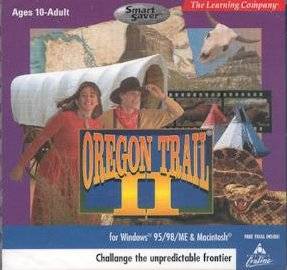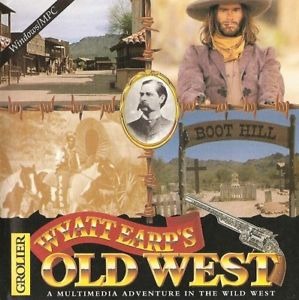 W
WAttentat 1942 is a Czech point-and-click adventure game, in which players take the role of Jindřich Jelínek's grandchild. Jelínek was arrested by the Gestapo shortly after the assassination of Reinhard Heydrich, ruler of the Nazi-occupied Czech lands and the leading architect of The Holocaust. The objective of the game is to establish what role he played in the attack, as well as the reason for his arrest. Throughout the investigation, players interview eyewitnesses, discover the family's back story and learn more about life in the Protectorate of Bohemia and Moravia.
 W
WGenesys is an educational video game, released in 2000 for Windows-based PCs and Apple Macintoshes. It was developed by Cybele Productions and Wanadoo Edition.
 W
WLes impressionnistes (Impressionists) is an educational video game released in 1997. The game focused on was developed by the French developer Index+ as a co-production with Réunion des Musées Nationaux.
 W
WJerusalem: The Three Roads to the Holy Land is a 2002 historical adventure game. The game was developed by Arxel Tribe and Réunion des Musées Nationaux, and published by Cryo Interactive. It is a sequel to the game Pompei: The Legend of Vesuvius.
 W
WMaking History II: The War of the World is a World War II grand strategy computer game released in June 2010 by developer Muzzy Lane Software. Making History II is the successor to Making History: The Calm & The Storm and gives players the ability to take full control of any world nation, colonies, regions, cities, and military units during the time leading up to and during the Second World War. In 2016, along with the other games in the series, Making History II was sold to Factus Games.
 W
WMaking History: The Calm & The Storm is a World War II grand strategy video game released in March 2007 by developer Muzzy Lane. Similar in ways to the popular board games Axis & Allies and Risk, Making History is turn-based with basic industrial, economic, resource, research and diplomatic management included.
 W
WMario Is Missing! is a 1993 educational game developed and published by The Software Toolworks for MS-DOS, Nintendo Entertainment System, and Super Nintendo Entertainment System. A Macintosh version was released in 1994. The player controls Luigi, who must travel around the world to find and return stolen treasures as part of a quest to find his brother, Mario, who has been captured by Bowser. Mario Is Missing!, part of a series of educational Mario games, marked Luigi's first starring role in a video game, which would not occur again until 2001, when Luigi's Mansion was released for the GameCube.
 W
WMario's Time Machine is an educational video game originally released for MS-DOS and then for the Nintendo Entertainment System and Super NES consoles. The Software Toolworks both developed and published the MS-DOS and Super NES versions in 1993, while the NES version was developed by Radical Entertainment and published by The Software Toolworks in 1994. The Microsoft Windows version was re-released as Mario's Time Machine Deluxe in 1996.
 W
WNile: An Ancient Egyptian Quest is a 1997 educational point-and-click adventure game developed by American studio Stone House Productions and published by Simon & Schuster Interactive for Windows 95. Players rescue three pharaohs – of the Old, Middle, and New Kingdoms – by immersing themselves into ancient Egyptian culture and life. In the UK, it was published by Zablac Entertainment. The game is no longer available.
 W
WOpération Teddy Bear is an educational comic strip video game released in 1996. It was developed by Index+ and a co-production with Flammarion, and is written by Edouard Lussan.
 W
WThe Oregon Trail is a text-based strategy video game developed by Don Rawitsch, Bill Heinemann, and Paul Dillenberger in 1971 and produced by the Minnesota Educational Computing Consortium (MECC) beginning in 1975. It was developed by the three as a computer game to teach school children about the realities of 19th-century pioneer life on the Oregon Trail. In the game, the player assumes the role of a wagon leader guiding a party of settlers from Independence, Missouri, to Oregon City, Oregon via a covered wagon in 1847. Along the way the player must purchase supplies, hunt for food, and make choices on how to proceed along the trail while encountering random events such as storms and wagon breakdowns. The original versions of the game contain no graphics, as they were developed for computers that used teleprinters instead of computer monitors. A later Apple II port added a graphical shooting minigame.
 W
WThe Oregon Trail is a computer game developed by the Minnesota Educational Computing Consortium (MECC) and first released in 1985 for the Apple II. It was designed to teach students about the realities of 19th-century pioneer life on the Oregon Trail. In the game, the player assumes the role of a wagon leader guiding a party of settlers from Independence, Missouri, to Oregon's Willamette Valley via a covered wagon in 1848.
 W
WOregon Trail II is an educational video game released by MECC in 1995. It was published by SoftKey Multimedia. It is a revised version of the original The Oregon Trail video game. It was redesigned with the help of American Studies PhD Wayne Studer. In contrast to the original version of the game, Oregon Trail II made an effort to include greater roles for women and racial minorities.
 W
WPompei: The Legend of Vesuvius, also known as TimeScape: Journey to Pompeii, is a 2000 historical adventure game. The game was developed by Arxel Tribe and Réunion des Musées Nationaux, and published by Cryo Interactive. It is followed by a sequel, Jerusalem: The Three Roads to the Holy Land.
 W
WTalvisota: Icy Hell is a real-time tactics and educational computer game, developed by the international developer group Blitzfront Game Studio and is based on the events of the Winter War conflict of 1939–1940 between Finland and the Soviet Union. The game is built-up upon Nival Interactive's Enigma Engine that was used in the Blitzkrieg game and is a fully stand-alone product.
 W
WWyatt Earp's Old West is a computer game developed by Grolier Electronic Publishing in 1994 for the IBM PC and Macintosh.